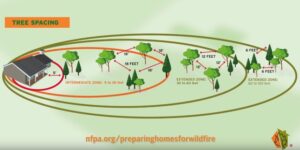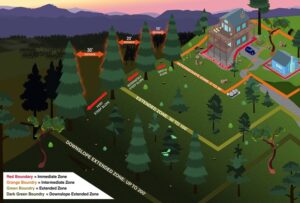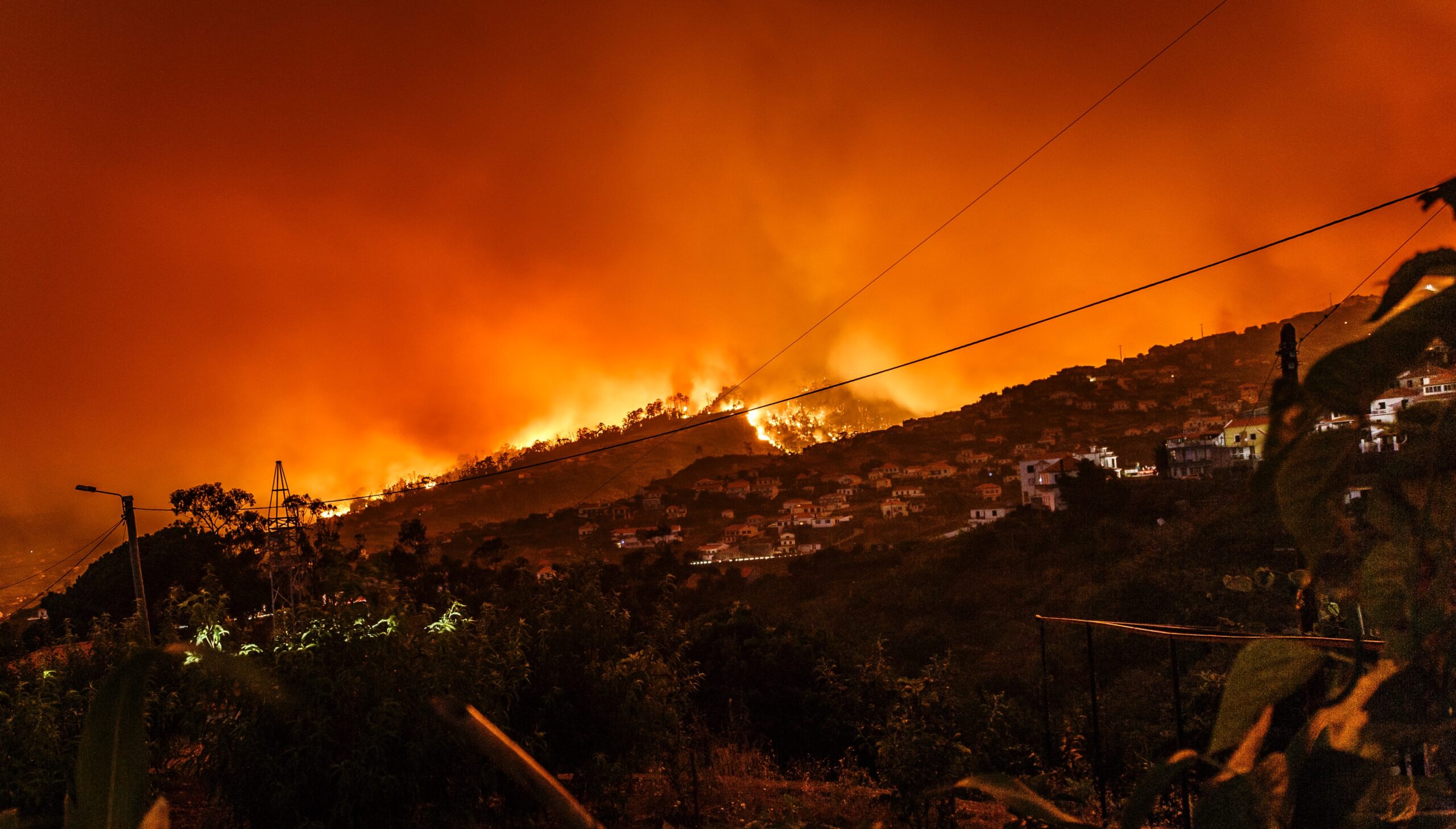In these unprecedented times, with emergency situations seemingly occurring more than ever before, it is important for performing arts organizations and outdoor festivals to maintain an all-hazards focus when it comes to emergency and disaster preparedness. To stay ahead of the risk, it is useful to engage in continual risk assessment and mitigation projects accordingly. As the summer months are right around the corner, this means the wildfire risk will soon be upon us. Thankfully, there are proven steps your organization can take to reduce the chances of interruptions to services and operations as the result of damage from wildfire.
 In the United States, wildfires are responsible for an estimated $63 to $285 billion per year in losses even though $2 to $3 billion per year is spent supporting wildland fire suppression efforts . Whether naturally or human caused, this trend is expected to continue if not increase. In recognition of this unfortunate reality, the National Fire Protection Association (NFPA) has established a strategy called “Outthink Wildfire” to recommend action policies at the national and local levels. “The strategy is rooted in two realities – wildfires are going to happen, and the fire service will not be able to extinguish these fires at a pace to save people and property in their path.”
In the United States, wildfires are responsible for an estimated $63 to $285 billion per year in losses even though $2 to $3 billion per year is spent supporting wildland fire suppression efforts . Whether naturally or human caused, this trend is expected to continue if not increase. In recognition of this unfortunate reality, the National Fire Protection Association (NFPA) has established a strategy called “Outthink Wildfire” to recommend action policies at the national and local levels. “The strategy is rooted in two realities – wildfires are going to happen, and the fire service will not be able to extinguish these fires at a pace to save people and property in their path.”
In 2017, the Luther Burbank Center in Santa Rosa, CA was affected by such damage. The performing arts organization in Santa Rosa, CA wrote that its “main building appears to have minimal damage, but that its classrooms and east end are destroyed.” Another example comes from the Britt Music and Arts Festival in southern Oregon in July, 2019. “The festival’s protocols to deal with delays and relocations related to air quality have evolved with several new solutions this season. Wildfire smoke the last two years have devastated OSF’s bottom line.”
What does this mean for a performing arts organization? Considering the NFPA’s position that the risk is growing and that resources are strained, it is imperative that performing arts organizations and festival planners alike take steps to minimize fire exposure to their structures or operations. Specific to organizations and buildings, there are two considerations. First, ensure your organization develops a comprehensive emergency plan that addresses disasters and emergencies of all kinds. Second, implement defensible space strategies from Firewise USA to minimize wildfire risk at your location.
Emergency Plans
Working with local first responders, and using Performing Arts Readiness resources and informational tools are excellent ways to develop a truly useful emergency plan. Engaging in risk analysis with your emergency management office or the fire department is essential to determining the extent of your risk for wildfire, and any other hazard. The emergency plan typically provides information applicable to any emergency, but also provides specific annex plans customized for each risk. A unique addition to these can be a “Personal Care” annex that arms employees with information on preparing their loved ones for emergencies and evacuations. After all, your employees are essential to the survival and recovery of your organization. If you help them prepare, they will be in a better position to help the organization.
Another element, essential to the safety of people and the continuity of your operations, is a thoughtful evacuation plan. It is best if these are rehearsed by trained staff, and direction is given to audiences before every performance. Especially in a wildfire scenario, a step-by-step approach to planning will ensure critical actions are accomplished before the fire arrives. As the situation develops, maintain awareness of public safety messages from the local authorities; most times you will have time to implement your plan. An important component of the evacuation plan is the identification of critical documents, data, and any item essential to the continuation of the business. These might include property deeds, portable hard drives, insurance documents, etc. Other plan elements include designating specific roles and responsibilities to employees, identifying 2 routes out of the area, and coordinating a meeting point that is completely out of fire risk areas. The plan should culminate with a group meeting to ensure all employees are accounted for, and to review the results of what has happened.
Defensible Space
 Firewise USA (www.firewise.org) is a public education and action program sponsored by the NFPA. Specific actions are made available to homeowners and businesses for the reduction of wildfire risk. The primary strategy is creating defensible space using the Ignition Zones principle. Based on USDA Forest Service research, this principle establishes zones at 5ft., 30ft., and 100ft. distances from the primary structure. It also recommends spacing of trees at 18ft., 12ft., and 6ft. increments according to the Ignition Zones (see Tree Spacing image).
Firewise USA (www.firewise.org) is a public education and action program sponsored by the NFPA. Specific actions are made available to homeowners and businesses for the reduction of wildfire risk. The primary strategy is creating defensible space using the Ignition Zones principle. Based on USDA Forest Service research, this principle establishes zones at 5ft., 30ft., and 100ft. distances from the primary structure. It also recommends spacing of trees at 18ft., 12ft., and 6ft. increments according to the Ignition Zones (see Tree Spacing image).
 As the most vulnerable to embers, the 5ft. zone is considered a non-combustible area. Including the structure itself, all combustible materials (shrubs and trees) should be removed within this zone. Metal mesh screens (1/8”) should be applied to all vent openings on the structure, propane tanks should be re-located, and all debris should be cleared from the building’s roof and eaves.
As the most vulnerable to embers, the 5ft. zone is considered a non-combustible area. Including the structure itself, all combustible materials (shrubs and trees) should be removed within this zone. Metal mesh screens (1/8”) should be applied to all vent openings on the structure, propane tanks should be re-located, and all debris should be cleared from the building’s roof and eaves.
The next zone, from 5ft. to 30ft., should focus on mindful landscaping. Maintaining lawns to a 4” height, and properly spacing shrubs and trees are important elements. Additionally, removal of ladder fuels (vegetation under trees) so a surface fire cannot reach into the trees is critical. Prune trees up to six to ten feet from the ground; for shorter trees do not exceed 1/3 of the overall tree height.
Lastly, from 30ft. to 100ft., the goal is to establish fire breaks and keep flames smaller and on the ground. Pay attention to outbuildings or storage sheds to remove any combustible materials, remove dead trees or accumulations of debris. Thinning clumps or stands of trees is also useful; this will reduce the likelihood of a fire jumping from tree to tree.
While there is no magic bullet to prevent any emergency, there are always steps we can take that minimize risk and improve the chances of escaping damage. During a wildfire, firefighters quite often engage in structure triage to determine what buildings are more likely to benefit from their protective measures. “During a wildfire that threatens multiple homes, firefighting resources are often limited, and firefighters must make quick decisions on which homes they can work on defending.” Taking steps to reduce your organization’s risk is a truly empowering undertaking that has a distinct advantage in survivability.
Additionally, and perhaps more significantly, participating in a Firewise USA program is a way to increase your community’s resilience profile. By reducing your fire risk, your neighbors’ risk is also reduced. By participating in these strategies, your organization can lead by example. By completing a wildfire preparedness plan, your organization is more likely to survive and thrive.
•••
Chris Soliz ([email protected]) is a PAR project consultant. After a successful 28-year career as a firefighter and emergency management professional, he now works with non-profits for fire safety and preparedness. He has worked with government, private, and non-profit organizations to develop plans, command large-scale emergencies, manage special events, and coordinate resource management. Chris holds a master’s degree in Emergency Services Management and is credentialed as an Incident Commander for North Carolina’s Incident Management Team. He is currently an Instructor for Western Carolina University’s Emergency Management Degree Program and also serves on the Board of Directors for the Family Crisis Council; a non-profit organization whose mission is to empower victims of sexual assault and domestic violence to take back their lives.
Notes:
- Outthink Wildfire, 2021, https://www.nfpa.org/wildfirepolicy
- New York Times, 2017, https://www.nytimes.com/2017/10/10/arts/luther-burbank-center-california-wildfire-damage.html
- Oregon Public Broadcasting, 2019, https://www.opb.org/news/article/oregon-arts-countermeasures-for-milepost-97-wildifre/
- Firewise USA, 2021, https://www.nfpa.org/Public-Education/Fire-causes-and-risks/Wildfire/Wildfire-safety-tips
- Firefighters Can’t Do It Alone, 2021, https://www.nfpa.org/-/media/Files/News-and-Research/Fire-statistics-and-reports/WUI/WUINeedsSummaryResidents.ashx

